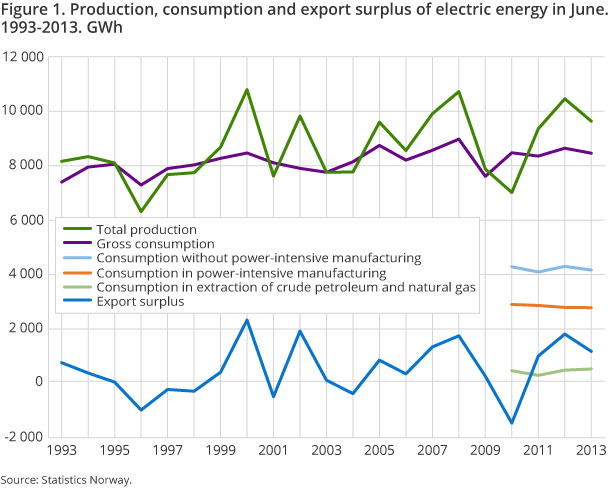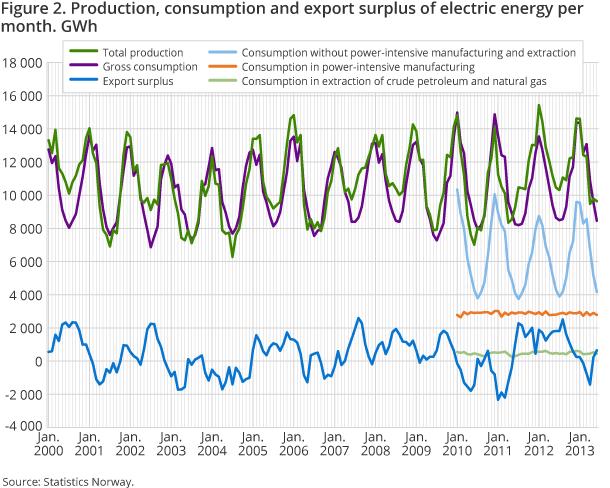Content
Published:
This is an archived release.
Low electricity generation
Electricity production came to 68.2 TWh in the first half of 2013. This is 11 per cent lower than the same period last year, which was the highest level ever recorded for the first six months in a year.
| June 2013 | Percentages | Change in per cent from the same month in last year | |
|---|---|---|---|
| Total production of power | 9 636 | 100,0 | -7.9 |
| Hydro power | 9 270 | 96.2 | -8.4 |
| Thermal power | 271 | 2.8 | 2.0 |
| Wind power | 95 | 1.0 | 32.0 |
| Net consumption of electricity | 7 397 | 100,0 | -2.4 |
| Consumption in extraction of crude petroleum and natural gas | 447 | 6.0 | -8.6 |
| Total consumption of electricity in power intensive manufacturing | 2 784 | 37.6 | -0.3 |
| Consumption without power intensive manufacturing | 4 166 | 56.3 | -3.1 |
The reduction in electricity generation may be seen in light of a lower amount of water in the Norwegian reservoirs for much of the first six months of 2013 compared to the same period in 2012. At the beginning of January, the reservoir filling was 68.8 per cent, according to the Norwegian Water Resources and Energy Directorate. This is 9.4 percentage points below the filling level at the beginning of January 2012. Compared to the first half of 2012, thermal power production was reduced by 13 per cent, while wind power production increased by 10 per cent. Thermal and wind production amounted to 1.5 and 0.8 TWh respectively in the first half of 2013.
From a record high net export to a net import of electricity
Norway’s export of power totalled 6.7 TWh in the first half of 2013, while imports came to 7.4 TWh. This gave a net import of 0.7 TWh. In the same period last year, Norway had a net export of a record high 10 TWh. Exchange of power between countries is determined by differences in generation and the consumption situation, prices, and the capacity of the power lines.
Rise in the total electricity consumption
The total gross consumption of electricity came to 68.9 TWh in the first half of 2013, an increase of 3.7 per cent compared to the same period in 2012. The increase in total gross consumption of electricity was due to higher electricity consumption in the consumption of households, services etc. The gross consumption of electricity encompasses consumption in the groups extraction of crude oil and natural gas, power-intensive manufacturing and electricity consumption excluding power-intensive manufacturing and extraction. Net loss, pump storage use and other own consumption in the power stations are also included.
Lower electricity consumption in extraction of crude oil and natural gas
Electricity consumption in plants for extraction of crude petroleum and natural gas on the mainland, including electricity distributed from the mainland to the Norwegian shelf, amounted to 2.9 TWh in the first half of 2013. This is 11 per cent lower than the corresponding period last year. The electricity consumption in extraction on the mainland encompasses receiving and processing plants for crude oil and natural gas.
Unchanged consumption in power-intensive manufacturing
Electricity consumption in power-intensive manufacturing was 17.1 TWh in the first half of 2013. This is approximately the same as the same period in 2012. Power-intensive manufacturing utilises electricity for the production of goods. Hence, the electricity consumption is not influenced by temperature.
Increase in the electricity consumption of households, services etc.
Electricity consumption excluding power-intensive manufacturing and extraction amounted to 42.4 TWh in the first half of 2013, an increase of 7.3 per cent compared to the same period in 2012. Households, services and manufacturing other than the power-intensive manufacturing account for the majority of the electricity consumption excluding power-intensive manufacturing and extraction. Electricity consumption in households amounts to approximately 50 per cent of the electricity consumption excluding power-intensive manufacturing and extraction.
Contact
-
Magne Holstad
E-mail: magne.holstad@ssb.no
tel.: (+47) 40 90 23 42
-
Ingvild Røstøen Ruen
E-mail: ingvild.ruen@ssb.no
tel.: (+47) 40 81 13 97
-
Tom Jonas Billit
E-mail: tom.billit@ssb.no
tel.: (+47) 40 81 13 45
-
Thomas Aanensen
E-mail: thomas.aanensen@ssb.no
tel.: (+47) 40 90 23 48


